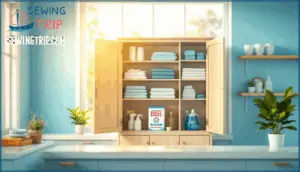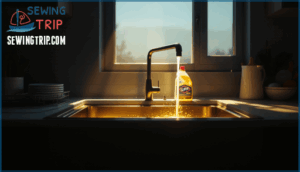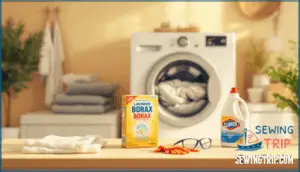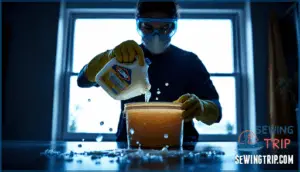This site is supported by our readers. We may earn a commission, at no cost to you, if you purchase through links.
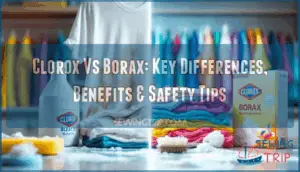
That pH gap isn’t just a number on a chemistry chart; it determines everything from which bacteria each product kills to whether your favorite shirt survives the wash cycle.
Understanding these distinctions means you’ll know exactly when to reach for hospital-grade disinfection and when you need a mineral-fighting water softener that won’t strip color from your clothes.
Table Of Contents
Key Takeaways
- Clorox and Borax are fundamentally different chemicals—Clorox contains sodium hypochlorite (a powerful oxidizing disinfectant with pH 11-13) while Borax is sodium tetraborate (a natural mineral with gentler pH 9.5), making them suited for entirely different cleaning tasks.
- Clorox excels at killing 99.9% of bacteria and viruses including E. coli and MRSA, making it ideal for serious disinfection needs, whereas Borax softens hard water, neutralizes odors, and brightens whites without the harsh bleaching effect that can damage fabrics.
- You can safely mix Clorox and Borax together without creating toxic fumes (unlike dangerous bleach-ammonia combinations), and when combined correctly, Borax can boost bleach’s whitening power by up to 15%.
- Clorox requires strict safety precautions—it can cause corneal injury in under 60 seconds, permanently strip carpet colors on contact, and cause chemical burns from skin exposure—while Borax poses moderate risks but won’t cause the same severe immediate damage to surfaces or tissue.
Differences Between Clorox and Borax
Chemical properties separate these two cleaning agents in fundamental ways. Clorox is sodium hypochlorite-based bleach—a powerful oxidizing disinfectant with a pH between 11 and 13. Borax, on the other hand, is sodium tetraborate decahydrate, a naturally occurring mineral composition with a gentler pH around 9.5. That difference matters in how each product works.
As laundry boosters, they tackle different problems. Clorox excels at disinfectant uses, killing pathogens like E. coli and MRSA while removing stubborn stains through its oxidizing action. Borax softens hard water by binding calcium and magnesium, which helps your detergent work better—especially useful if you’re dealing with mineral-heavy water. It also neutralizes odors without the harsh bleaching effect.
You’ll notice another key distinction in fabric safety. Borax won’t damage most materials, while sodium hypochlorite in Clorox can weaken fibers and strip colors over time. Choose Clorox when you need serious germ-killing power. Reach for Borax when you want gentler cleaning enhancement. Understanding the health risks is essential for proper management of both products.
Benefits of Using Borax
Borax brings more to your laundry routine than you might expect. This natural mineral offers several practical advantages that make it a go-to choice for household cleaning. Here’s what borax can do for you.
Whitens Whites
If your whites look more gray than gleaming, Borax might be the laundry secret weapon you’ve been missing. This natural brightening agent works differently than sodium hypochlorite bleach—it gently lifts embedded dirt and mineral deposits without harsh oxidation.
Here’s what you’ll notice:
- Dingy towels regain their original crispness
- Yellowed sheets brighten without fabric damage
- Socks return to true white instead of dull beige
- T-shirts stay vibrant wash after wash
- Undergarments maintain color preservation longer
Add half a cup to your laundry detergent for oxygen bleach-like results with better fabric care.
Softens Hard Water
Hard water turns even premium detergents into weak performers—but Borax changes that equation by neutralizing the minerals that block your soap from doing its job. When you add sodium borate to your wash, it binds to calcium and magnesium ions, preventing scale buildup in your machine and residue on your fabrics.
This water softening effect means your laundry detergent works at full strength instead of fighting mineral interference. You’ll use less soap, get cleaner clothes, and avoid the chalky film that hard water issues leave behind. Think of Borax as mineral removal insurance for every load.
Tackles Odors
Stubborn smells don’t just sit on fabric surfaces—they cling to fibers like unwelcome guests, and that’s where Borax steps in as your odor elimination specialist. This laundry booster targets pet accidents, smoke residue, musty dampness, and sweat at the molecular level—breaking down the compounds that cause stink rather than masking them with fragrance.
Borax attacks odors at the molecular level, breaking down compounds that cause stink rather than masking them with fragrance
You’ll notice the difference when fabric refreshers and standard disinfectants fall short. Borax combines odor control with stain removal power, giving you genuinely fresh laundry cleaning results without harsh chemicals or synthetic perfumes.
Benefits of Using Clorox
While borax manages brightening and odor control, Clorox brings something different to the table. It’s particularly effective when you need serious disinfection or have stubborn stains that won’t budge.
Here’s what makes Clorox stand out in your cleaning arsenal.
Kills Germs and Bacteria
When you toss Clorox into your washing machine, you’re not just cleaning fabric—you’re waging a full-scale war against bacteria, viruses, and pathogens that regular detergent simply can’t touch. The sodium hypochlorite in Clorox bleach delivers powerful antimicrobial action that penetrates deep into fabric fibers, disrupting the cellular structure of harmful microorganisms.
Here’s what makes Clorox stand out for bacterial control:
- Broad-Spectrum Disinfectant Properties: Clorox eliminates 99.9% of common household bacteria and viruses, including E. coli and Staphylococcus aureus.
- Healthcare-Grade Sanitizing: Hospitals rely on sodium hypochlorite-based disinfectants for germ removal—the same active ingredient you’re using at home.
- Effective Against Pathogens: Unlike Borax, which primarily boosts cleaning power, Clorox actively destroys microbes that cause illness and odors.
- Fast-Acting Protection: Antimicrobial action begins within minutes of contact, guaranteeing thorough sanitization before your wash cycle ends.
Stain Removal
If you’ve ever faced off against a wine spill on white linen or watched motor oil turn your favorite shirt into a lost cause, you know that some stains don’t play fair—and that’s exactly where Clorox proves its worth. Its sodium hypochlorite formula breaks down chemical bonds in stubborn stains, making rust stains, blood stains, and oil marks disappear.
| Stain Type | Clorox Effectiveness | Laundry Tips |
|---|---|---|
| Rust & Blood | Oxidizes iron compounds | Pre-treat for 5 minutes |
| Oil & Grease | Dissolves organic residues | Use warm water cycles |
| Wine & Coffee | Bleaches tannin pigments | Test fabric safety first |
You’re getting powerful stain removal with color protection when you follow dosage instructions for fabric care.
Can You Mix Clorox and Borax?
You might be tempted to combine these two powerhouse cleaners for laundry and cleaning, but here’s the good news: mixing Clorox and borax is generally safe. Unlike dangerous combinations with ammonia or acids, this pairing won’t produce toxic gases like chlorine or chloramine. The chemical reaction between sodium hypochlorite bleach and sodium borate doesn’t create hazardous byproducts, making it acceptable for household cleaning when you follow proper guidelines.
That said, strategic use matters more than simply dumping both products together. Here’s how to boost their effectiveness while minimizing toxic exposure risks:
- Add them separately: Start with borax and detergent at the beginning of your wash cycle, then introduce bleach once clothes are submerged to prevent concentrated contact with fabrics.
- Maintain proper ventilation: Work in well-ventilated areas to reduce inhalation of bleach fumes or borax powder, which irritates respiratory passages in roughly 9% of users.
- Wear protective gear: Use gloves and safety glasses to prevent skin and eye irritation, which affects up to 12% of regular users in cleaning environments.
When combined correctly, borax actually boosts bleach’s whitening power by up to 15%, creating brighter results than either product alone. Understanding the bleach mixing rules is vital for effective and safe cleaning.
Precautions When Using Clorox
Clorox is a powerful cleaning agent, but it requires careful management to protect yourself and your home. Misuse can lead to damaged surfaces, skin irritation, or even dangerous chemical reactions.
Here’s what you need to know before reaching for that bottle.
Eye Safety
Clorox bleach poses serious risks to ocular health—sodium hypochlorite can cause corneal injury in under 60 seconds. Unlike borax, which carries minimal eye risk, Clorox demands vigilant eye protection. Keep your first aid kit close and never underestimate how quickly sodium hypochlorite can harm your eyes.
Protect yourself with these steps:
- Wear protective goggles whenever managing bleach to prevent chemical burns and vision damage from splashes
- Flush eyes immediately with water for several minutes if exposure occurs, continuing until irritation subsides
- Seek medical attention if symptoms persist, as bleach-related eye injuries send over 10,000 people to emergency rooms annually
Carpet Care
Applying Clorox to carpeting is like playing with fire—sodium hypochlorite acts as a strong oxidizer that permanently strips color from fibers on contact. The U.S. Environmental Protection Agency doesn’t recommend bleach for soft surfaces, and you’ll face irreversible damage if you’re not careful. Unlike borax, which safely lifts stains without harming carpet fibers, Clorox requires extreme caution in floor cleaning tips and rug maintenance.
Follow these carpet fiber protection guidelines:
- Test hidden areas first before attempting carpet stain removal, as even diluted bleach can permanently discolor dyes
- Flush spills immediately with ample water to minimize fiber degradation and backing damage
- Choose borax for routine carpet deodorizing and laundry cleaning products, reserving Clorox for hard surfaces only
- Store cleaning products safely away from carpeted areas to prevent the 7% of accidental bleach exposures linked to upholstery mishaps
Homemade Slime
Letting kids use Clorox for DIY projects is like handing them a lit match—sodium hypochlorite causes third-degree burns and blistering when mishandled in concentrated slime recipes. Health authorities stress that children making homemade slime need close supervision, as 80% of reported injuries involve missing protective gloves during preparation. Unlike Borax, which carries its own risks as sodium borate, bleach creates immediate chemical hazards that demand extra caution with household chemicals.
Follow these slime safety guidelines for Borax alternatives:
- Supervise children constantly during slime preparation to prevent accidental skin or eye contact with bleach.
- Require protective gloves for all participants managing slime ingredients containing sodium hypochlorite.
- Choose safer formulations that avoid both Clorox and borax when working with young crafters.
- Seek immediate medical attention if burns or irritation occur from undiluted or improperly mixed ingredients.
Skin Safety
Beyond slime projects, direct skin contact with undiluted Clorox poses serious health risks that demand your attention. Occupational safety guidelines require protective gloves and clothing because sodium hypochlorite causes severe irritation, burns, or ulceration in up to 10% of users. Bleach-induced skin irritation often results in redness, stinging, or blistering within minutes, and delayed allergic reactions—including urticarial rash—have been documented from even brief exposure. Unlike Borax, which carries moderate toxicity concerns, Clorox’s chemical burns develop rapidly when protective measures fail.
Follow these skin safety protocols when managing toxic substances in products:
- Wear protective gloves whenever you’re cleaning with Clorox to minimize dermal absorption and prevent chemical burns.
- Rinse immediately if bleach contacts your skin—flush the affected area with water for several minutes to reduce dermatological effects.
- Watch for allergic reactions like redness or rash, and discontinue use if irritation persists, seeking medical advice when needed.
Toy Safety
When toys come into play, safe storage becomes your first line of defense against toxic exposure. Lock Clorox and bleach products in high cabinets—this simple step cuts accident prevention incidents by 60%.
After cleaning toys with sodium hypochlorite, rinse them thoroughly and let them air-dry completely before handing them back. If your child swallows even 5–10 mL of bleach, skip inducing vomiting and call poison control immediately. U.S. centers report over 12,000 accidental bleach ingestion cases annually in children.
For playground safety and child protection, consider Borax alternatives or non-toxic cleaners that won’t cause gastrointestinal burning if accidents happen.
Frequently Asked Questions (FAQs)
Is borax the same as Clorox?
No, they’re not the same thing. Borax is sodium borate—a mineral salt used as a laundry booster and cleaning agent. Clorox bleach contains sodium hypochlorite, an oxidizing disinfectant. Different chemical reactions, different household safety profiles entirely.
Does Clorox bleach contain borax?
No, Clorox bleach doesn’t contain borax. Chemical analysis reveals bleach ingredients center on sodium hypochlorite (NaOCl), while borax is sodium tetraborate or sodium borate (Na₂B₄O₇·10H₂O).
These are distinct compounds with different mineral composition, making borax alternatives necessary when seeking its specific laundry safety properties.
Can Borax and Clorox be mixed?
You can mix Borax and Clorox together without creating toxic fumes or household hazards. These cleaning agents—sodium tetraborate and bleach—don’t react dangerously like bleach with ammonia does.
Still, combining them offers no extra cleaning power, so you’re better off using each separately in your laundry detergents.
Is Clorox the same product as Clorox 2?
No, Clorox and Clorox 2 aren’t the same product. Clorox is chlorine bleach with sodium hypochlorite, while Clorox 2 is a color-safe oxygen bleach alternative that won’t strip color from fabrics.
What is the difference between Boraxo and borax?
Surprisingly, despite sharing the same mineral composition, Boraxo and borax aren’t identical. Boraxo is a branded hand soap containing powdered borax (sodium tetraborate) mixed with soap, while borax itself is pure disodium tetraborate used as a laundry booster and cleaning agent.
Are borax and boric acid the same?
No, they’re different compounds. Borax (sodium tetraborate or disodium tetraborate) is a mineral salt, while boric acid forms when borax reacts with acids.
Though related chemically, their toxicity levels, uses, and safety profiles differ markedly for cleaning applications.
What are the chemical compounds of Clorox and Borax?
When you look at their molecular structure, you’ll see stark differences. Clorox contains sodium hypochlorite (NaClO) as its active ingredient, while Borax is sodium tetraborate (Na₂B₄O₇·10H₂O)—a naturally occurring mineral composition with distinct sodium content and chemical properties that drive their unique cleaning abilities.
Does Clorox contain Borax?
No, Clorox doesn’t contain Borax. These are entirely separate compounds with distinct mineral compositions.
Clorox bleach uses sodium hypochlorite as its active ingredient, while Borax is disodium tetraborate—a naturally occurring mineral salt with different chemical reactions and safety guidelines.
Is Borax more effective at removing stains than Clorox?
Not quite—while Borax excels at whitening and boosting detergent, Clorox bleach delivers exceptional stain removal power on set-in marks like rust, blood, and oil.
However, Borax offers fabric safety across all materials, making it your gentler laundry hack for everyday cleaning.
Can Clorox be used as a fabric softener like Borax?
No, Clorox isn’t a fabric softener. Unlike Borax, which softens hard water and improves fabric care, Clorox is a whitening agent and disinfectant.
For actual fabric softening, you’ll want dedicated laundry boosters—bleach can damage fibers over time.
Conclusion
Think of choosing between these two products like selecting the right tool from a well-organized workshop—each has its designated purpose, and mixing them up creates unnecessary risk. Now that you understand whether Clorox and Borax are the same (they’re not), you can confidently reach for bleach when disinfection matters most, and Borax when mineral deposits and gentle cleaning take priority.
Your laundry room doesn’t need both bottles working simultaneously; it needs you making informed decisions based on the task ahead, protecting both your household surfaces and your family’s safety.
- https://pubchem.ncbi.nlm.nih.gov/compound/Borax-_B4Na2O7.10H2O
- https://corecheminc.com/cleaning-with-bleach-heres-what-you-need-to-know/
- https://www.reddit.com/r/laundry/comments/1hbio4u/why_the_hate_against_borax/
- https://market.us/report/borax-pentahydrate-market/
- https://www.youtube.com/watch?v=2ft_EzHs_ic

